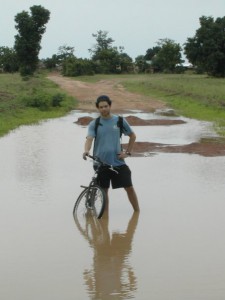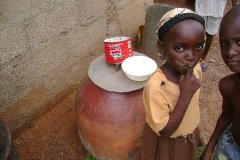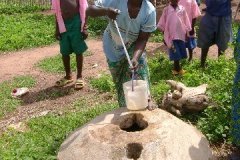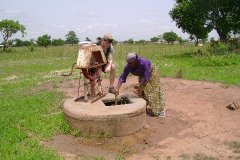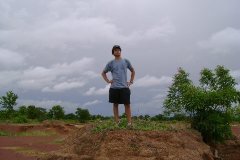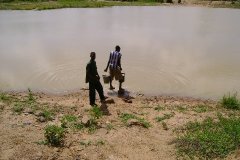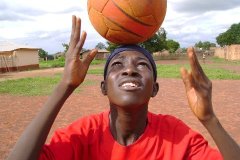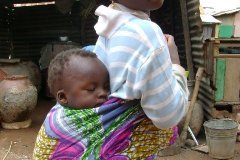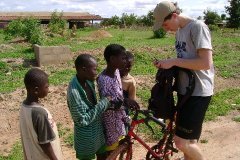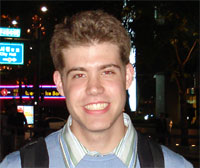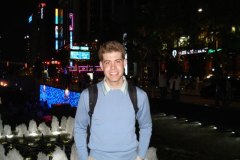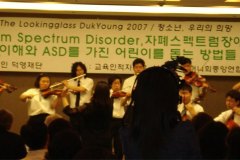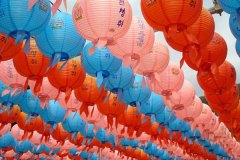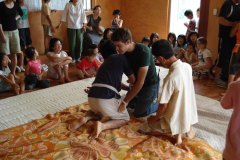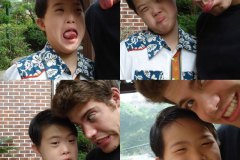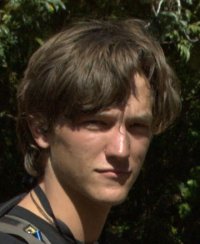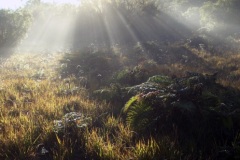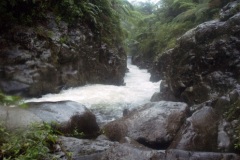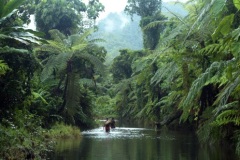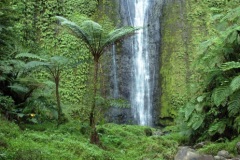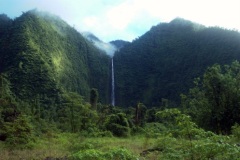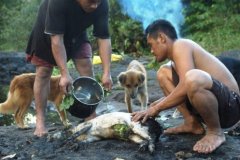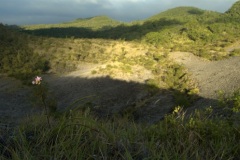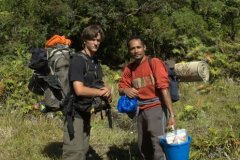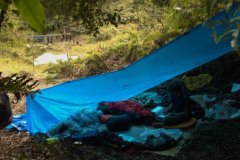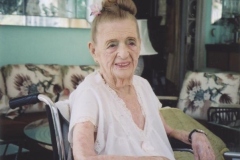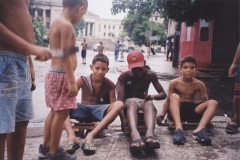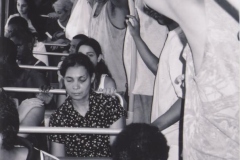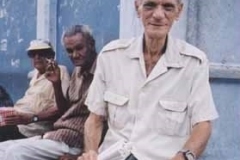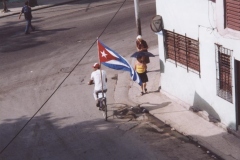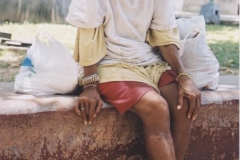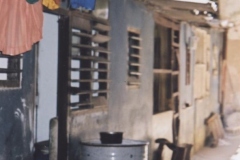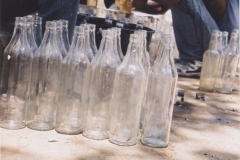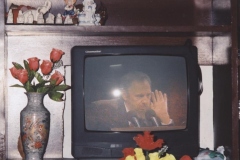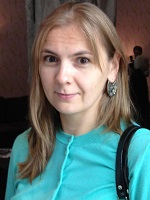2000s
Conducting water-quality research around the city of Tamale
Jake Cohen Silliman, Class of 2012Thanks to the generosity of the Chase Coggins Memorial Fund, I was able to spend six weeks in Ghana this summer, conducting water-quality research around the city of Tamale. When I first became interested in taking on a water project in Ghana, I intended to set up a sachet-water business to provide clean water for people and to help the NGO Pure Home Water (PHW) become financially self-sustaining. "Sachets" are literally plastic bags filled with 500 milliliters of water; girls, and some women, carry them on their head in ice buckets and sell them on the street for 5 Ghana pesues, the equivalent of 3 US cents. Though it is a tiresome and often-thankless job, it pays relatively well: sachet girls, as they are called, buy packs of 30 sachets at kiosks for 75 pesues; if they sell them all, they make 150 pesues: a profit of 75 pesues. Though 75 pesues, about 60 cents, for a few hours of work isn’t much by our standards, it offers girls the opportunity to supplement their parent’s income (and, in some cases, make up for the lack thereof).
Setting up a sachet business for PHW posed a number of potential problems, however. First, our only method for filtering water would have been with the ceramic pot filters that the NGO sold; while great for domestic use, they filter water far too slowly to mass-produce sachets. Other sachet businesses had much more specialized and efficient filtering techniques: large scale UV-ray filters, sand and carbon filters, and micron filters. While we could have invested in setting up a factory with the appropriate equipment, it was not clear enough that selling sachets was the only way to make PHW self-sustaining. Second, though sachet businesses were extremely lucrative in the early nineties, when only two or three companies existed, the dozens of businesses in operation now make it exceedingly difficult to succeed, especially with some sketchy businesses not even filtering their water. And last, we knew that selling sachets was only a temporary fix, both for PHW’s problem of becoming self-sustaining and for Tamale’s problem of having clean water.
Instead, I, along with Jesse Williams*, who is also a sophomore at Yale, studied the water quality in the city of Tamale. I must clarify, however, that though Tamale is technically a city—it has a population of 220,000—it is far removed from our Western conception of a city: no more than a dozen paved roads start in the center of "town" and then go out in every direction for one or two miles, quickly fading into dirt roads in a vast and endless savannah.
Biking out to a different two or three villages every morning, Jesse and I collected and analyzed over 130 water samples. The water samples came from a variety of sources: dugouts, wells, ponds, rivers, pipes, and rain water, and we either collected them directly from the source or from the clay pots and oil drums in which people stored their water. Our interactions with the people at these villages were unpredictable, illumiating, and always memorable. Language, primarily, made things interesting: although English is Ghana’s official language, every region has a different language and only those who go to school speak English, so Jesse and I were forced to learn the rudiments of Dagbani, the language in the Northern Region, where we were. In trying to explain ourselves to the people at the villages we visited, we relied on a combination of motions, a few well-rehearsed Dagbani phrases, lots of smiling, and, when we were lucky, someone in the village who spoke English. Despite the language barriers, the people in Tamale were some of the warmest and most hospitable people I’ve ever encountered. (One of the best friends I made, Zaki, who spoke no English, wouldn’t let me leave his house without taking a basket full of guinea fowl eggs.)
In a "lab" at the house that PHW owned, we conducted four different tests on the water (this "lab" was probably farther from the Western conception of a lab than Tamale was from that of a city—it consisted of a small room with a fridge, a stove, an incubator, a heat-pressing machine, and a closet full of supplies students had brought from the US). One of the objectives of our research was to demonstrate that the combination of two cheap tests that require no electricity could provide the same level of information as a more expensive, energy-dependent test. The two cheap tests were Petrifilm and Collilert: Petrifilm consists of a medium on which E. coli and coliform can grow and be counted, and Collilert is positive/negative test for the presence of coliform and E. coli. Each one of these tests cost less than $1, and can be incubated using body heat. Quantitray, the more sophisticated and expensive test, also gives a count of the number of E. coli and total coliform, but it costs $10 per test and requires electricity to power a heat-pressing machine and an incubator. The last test we conducted, though not to study its effectiveness, was a positive/negative test for hydrogen sulfide bacteria, such as Salmonella.
Our data has shown that the combination of Petrifilm and Collilert do provide as much and as reliable information as Quantitray. The implications of this finding are far reaching, as NGO’s around the world that do not have electricity or enough money can now accurately test the quality of water. Perhaps more ambitiously, this finding could also allow for cities, and even villages, in the developing world to more readily monitor the quality of their water.
There were two other objectives in our study. One of them was to gather the data for a Google Maps-type of website, designed by MIT students, where one can click on a house or a water source in Tamale (or in the Phillipines, where a similar project took place, and hopefully elsewhere soon) and get a picture, the water quality, and a short story about that particular place. Though the website is not yet up, the stories about each sample, which Jesse and I switched off writing, are complete, and I am attaching the ones that I wrote in the appendix.
The last objective of our study was to gather the data for a sort of map of the water quality of Tamale, examining which areas have access to pipe water, which areas have wells and dugouts, and how the water quality varies throughout the villages. The purpose of this is to allow PHW to figure out which villages to target in terms of selling water filters, and how to target them, for clearly, villages that have access to pipe water are going to be unlikely to buy water filters.
Looking back on my time in Ghana, I can honestly say that this experience helped me grow immensely in nearly every way possible, not the least of which was academically. For one, my project reinforced my commitment to studying medicine. Listening to people talk about how many friends they’ve lost to malaria, how many kids die from dirty water, how many people go blind from trachoma and other preventable diseases—how much suffering is caused by diseases that we know how to prevent—makes it nearly impossible for me to not want to help, and I see medicine as the most direct route. At the same time, my experience in Ghana made me even more certain that I want to study history at Yale, for I’ve learned that one cannot solve problems—whether they are about selling water filters or toilers or bed nets, or eradicating guinea worm or preventing HIV/AIDS, or stopping genocide and corruption—simply by only looking at the problem through one lens, whether scientific, economic, or politcal. Cost-benefit analyses are useless when dealing with people who don’t reason based on economic interests; designing a filter that kills 99.99% of bacteria won’t do anything if the people you are trying to sell it to don’t see dirty water as a problem. Instead, what is going to make me most the best doctor, in both the US and the developing world, is an understanding of science and of people. This conviction has shaped my course of study at Yale, and I hope will continue to shape my academic and personal development.
Without the help of the Chase Coggins Memorial Fund, my experience would not have been possible. As such, I sincerely thank the Chase Coggins Memorial Fund for its tremendous generosity, and am forever indebted to it for giving me the opportunity to realize my passion. May the memory of Chase Frederick Coggins continue to empower people to change the world.
Appendix
*Jesse and I worked together throughout the project--from collecting the samples, to analyzing them, even to coaching soccer together. He was sick for a couple weeks so I went out by myself a lot, but we were together for the rest of the time.
These are the stories that I wrote about the samples that we collected. The number next to each story corresponds to the sample number, which can also be seen in the Excel file with all of the data, which I’ve attached separately. Most of the missing numbers correspond to stories that Jesse Williams, my partner in crime, wrote.
5. We arrived at Taha on our second day and were impressed by a public standpipe, only to be told that the waster was not running. Instead, a boy of about twelve led us by bike to this dugout, small, unclean, and the village’s main source of water.
7. A middle-aged woman showed us her water. It was in a clay storage pot, barely a brown puddle at the very bottom. "Dam water," she told us. The treatment? Merely poured through a cloth filter, and drank.
10. A rice field away from the main road, we found this long, brick house, which stood out from the mud houses we had gotten used to seeing. A young woman washed clothes and her little brothers ran around as their father showed us this clay storage pot. With no working municipal pipes, his wife and daughter fetch water from the Taha dam every day, and drink it just like that.
16. Deep in the sea of farms, four brothers emerged from a mud-hut compound. Soft-spoken but generous, they led us to this well. A bright orange star in an endless green sky, you would have thought the water was gold, but it was far, far from it.
18. Hidden behind a small hill in an otherwise flat land, this dugout, though not the dirtiest looking we had seen, proved to be as dirty as any. Even the heavy rain the night before didn’t help the water, though it did help make the rest of the journey a long, wet one. It featured a headfirst wipe out into a flood rice field by, of course, none other than myself.
20. Soaked in muddy water from head to toe, not excluding my digital camera, I rode grudgingly behind Jesse, who somehow managed to dodge every single muddy obstacle along the way. I finally smiled, however, when, upon our arrival at the village of Pauma, the group of women who greeted us pointed and laughed playfully at my dripping self. Out of the roaring crowd of women emerged a pregnant woman. With eyes and teeth that were tired and yellow, she told us in impeccable—and animated—English about the village’s problems: "We have nothing," she said. "No roads, no water."
22. When we left Bauma I was so ready to go home and forget about the "challenging" morning, that the last thing I wanted to do was to have to stop again. Of course, we stopped again. This time, we pulled over at a little pond hugging the side of the road. We had almost missed it, not because of how small it was, but because it was almost the color of the dirt all around it.
24. We had by this "Islamic Republic of Iran"-sponsored elementary school a couple days earlier, but as a school teacher informed us that there wasn’t enough water in the cement holding tank for it to come out. It having rained the night before, we tried again, and this time, though there still wasn’t enough pressure for the it to come through the faucet, the teacher told us he could get us water. He called a little boy named Rashid. As I knelt down next to the faucet with my plastic bag ready, uncertain of how this tiny boy was going to help, Rashid twisted his head under the faucet and began to suck on it, somehow "pulling" the water up from inside. With each pull producing only a fleeting flow of water, Rashid pulled and pulled until the bag was full, and, before I could even thank him, darted back to his classroom.
26. On our way to Goumane, a Grand Canyon-like valley appeared on the side of the dirt road. Like 8-year-old boys, we could smell fun, and we instinctively turned into it. It looked too much like the natural version of a skate park to pass up, and the brown puddles dotting it were perfect for chucking pebbles. Then, in the distance, on the far side of the valley of craters: a woman, collecting water.
28. Riding around one of the most striking landscapes we had seen—one of the few hills in the area—we passed a quiet primary school. As we strolled through the school’s yard, more and more kids started racing behind us until the whole school was in an impromptu recess. When we reach the main office, the principle, a large, stern-looking woman, ordered us to sit down. She listen carefully but seemed unmoved by what we said. Finally, she said simply, "When the kids are in school, they drink pipe water. But at home, all they have is the dam." She must have repeated that three times. And then, "you have to help them."
30. A woman holding a baby led us into her compound. She skillfully swung the baby onto its feet, and picked up an empty tomato can to scoop water out of large clay pot with. The baby started as my plastid bag filled with brown water.
32. Like most dugouts, you couldn’t actually see the water until you climbed over the rim of it. Once up there, it was an idyllic site, however: bushes lined the pond’s outskirts and the sun shone on its very center. The water itself, however, was a different story, saturated with E. coli.
34. The headmaster and a couple of teachers were sitting around a plastic table near the edge of an elementary school playground. Kids ran around like mosquitoes, kicking and chasing a flat soccer ball. As we walked through the playground, a teacher approached us and brought us over to the headmaster. When we explained ourselves to him, he offered to show us the school’s water source himself. He hopped on his bike and took off, as Jesse and I tried to keep up on ours. He led us to a sprawling dugout, and explained that students take turns walking over to the dugout and collecting water for the other students.
36. Across the main road from the school we had just been at, a village called Vitin lay hidden behind a row of kiosks. We approached the first house we saw, where we were given dugout water from a clay pot. The water didn’t turn out to be the worst we had seen, but it certainly wasn’t clean either.
38. Led by a little boy from the previous house, we came to a brick house that surrounded on a cement courtyard. Two well-dressed men welcomed us and took us over to a shower, where they get their water. Apparently, this house served as some sort of barracks, either military or, more likely, religious.
40. A woman in her early thirties greeted us. She spoke little English, and there was no one around to translate for us, so we kept our conversation simple and to the point. With a huge metal bowl, she scooped some water from an oil drum and splashed it into another metal bowl. Then, she filled one of our bags with water, which, surprisingly, was clean.
42-53. [Kula – no information written in field notebook.]
54. A man wearing a Germany soccer jersey looked at us suspiciously as we talked to his wife. When we turned and starting talking to him, however, his distrustful look faded into a friendly one, asking questions and commenting about our work.
56. On the side of the dirt road, a little girl, who couldn’t have been older than 12, scooped water from a puddle into metal buckets and bowls. She was diligent and proud of her work, and seemed annoyed that we stopped to talk at her. As soon as we left, after thanking her enthusiastically to make her seem less upset, she got right back to collecting water.
58. I can’t remember what the whole dugout looked like; I don’t know that I even saw. My eyes, and my camera, were fixed on the very edge of the water, right next to my feet. Faded footprints, empty Gatorades bottles, and black plastic bags stood motionless as warm, dirty water swirled around them. And to think that people drink this water.
60. A boy just a couple years younger than us walked us over to a little roof, under which were stacked a medley of pots of different colors and sizes, most filled with water. It was sad to think that you could take so much pride in the water you have, as this boy did, when the water you have is actually so dirty. Or maybe it’s inspiring? I don’t know…
62. Two eldlerly women sat on the cement ground with their backs on the wall, seemingly in the midst of some gossip. We gave them our usual shpiel, but they didn’t understand us. Luckily, three high school boys in uniform shirts were just getting on their bikes a few houses down, so we were able to get their attention. Osman, Alhassan, and Abulai translated for us, and, as usual, asked us for our numbers at the end.
64. Isn’t this a toilet, Jesse and I asked ourselves? As if reading our minds, or perhaps our puzzled looks, Seth, a gentle construction worker from the Volta Region, told us that they were in fact intended to be toilets, but when ground water was found during their construction, they decided to use them as wells. For some reason, they still finished building them as if they were toilets. Let’s just hope everyone is clear on what they are, Jesse and I thought.
67. A tall woman flung a rubber container down another one of the faux-toilet wells, and effortlessly pulled it full of water. When Jesse and I asked to have a try and, well, failed, the woman burst out laughing and saying something in Dagbani. Seth translated: she thought we were funny, and she wanted a gift from America. Unsure what to do, Jesse gave her his pen. She kept laughing, but as she held the pen between two fingers and examined it, said "Nandesogu," thank you.
68. We began past Kalpohin, a village right next to our house where we had been the day before. After making two or three U-turns—almost every dirt path seemed to be swallowed up by corn plants into another dead end—we came across an idyllic stream. Just down from where the path met the quiet stream, a majestic tree rose from the water. Confident that people in Kalpohin fetched water there, we took a sample. Perhaps the scene’s beauty improved the water’s quality, for, though still quite dirty, it was better than most.
70. I couldn’t take enough pictures. This brown-water dugout—and I mean brown—had countless footprints dotting the entirety of its shore. The slew of mud and still, warm water looked more like a plate of brownies and melted chocolate ice cream after being eaten by a six-year-old than the rim of body of water—drinking water, at that.
73. A soft-spoken woman clad in a beautiful mélange of purple and yellow fabrics led us to this well in the back of her farm. As was too commonplace, the well had a cement cover, but because the mechanism built to pull up water through a tube was broken, part of the cover had to remain open—leading the water in it to become extremely dirty.
77. Behold, a scene we quickly became accustomed to: Jesse and I walked into the front yard of this house in Kanvilli, a village right next to Tunayilli, and the woman who greeted us, unable to speak English, went into the house to get her sons, two of them, both extremely polite and with excellent English. They gave us water from a pipe inside their home: It was perfectly clean! Hallelujah!
78. Yakubu introduced us to his father and brother. We had already met Yakubu a few days back, while we were in a different village. We talked for a few minutes—the two brothers managed their English quite well, though their father had some trouble. Meanwhile, four of their younger siblings kneeled over a game of Mancala (knowing that this popular game had been invented in Africa, I had been looking out for it during my whole stay—I was so happy to finally find it!)
86, 87, and 88. We lucked out. Within minutes of our arrival at the Nalu Electrical District (the name, ironically, of a village without electricity), we were introduced to a group of four friends who gracefully guided us through their village. They were 20 and 21 years old. Gafaro and Amin were taxi drivers. Alu was a "sprayer," meaning he (spray-)painted motorcycles. Numan, however, still did not have a job. Curious, I asked him what he wanted to do. "Feed my family," he answered simply. "Well, of course," I responded, "but what kind of work do you want to do in order to feed your family?" This next line has stuck with me since: "Around here, one does not choose what job he wants to have," he said. "One takes whatever job he can take." They proceeded to take us to a number of places to get water. The last three were a tiny pond on the side of the road, one of the biggest dugouts I had seen, with goats and sheep grazing all around it, and pipe at a home.
94 and 95. Hassan was waiting for us next to his family’s kiosk. He was the boy who had taken us to a dugout on one of our first days. He led us to two wells we had not seen before, both nothing more than a hole in the ground reinforced with some sticks.
98. With Jesse suffering from the side effects of the antibiotic he took for an infected cut, I set out on my own. My destination was any village in the northwest of Tamale, a segment we had yet to explore. After knifing through the center of town and speeding down a long and hilly road, I reached the village of Nyanshego. Alone, I felt a lot more conspicuous; the first-day jitters that that had been washed away by the Ghanaians' overwhelming warmth and friendliness returned. After circling the village a couple times, I stopped hesitantly at cement house and tiptoed in. A father and son received me plainly, but as I explained myself, throwing in a few well-rehearsed Dagbani words, the pair began to laugh and ask me questions, and the jitters were once again erased. The water they gave me, supposedly from a municipal pipe, was as dirty as any.
-
Feeling more comfortable, I got back on my bike and stopped just a few houses down. From outside the front yard, I could see a mother trying to teach her baby to talk. The scene was almost too perfect to disturb. After hesitating for a few moments, I cleared my throat and said, "Despa." The woman looked up confusedly, and the unexpected sight of a white man made her clutch her baby against her chest. Nonetheless, she proceeded to greet me formally. As usual, a team of women, and one man, emerged from all corners of the house. My attempts to ask them about the weather and how their sleep was, in Dagbani, drew laughs, and they gave me a sample of their rainwater. As I was getting on my bike, a few feet outside the yard, the mother tapped me on the shoulder, and, still holding her baby, asked to hear more about my work.
100. From my conversation with the previous woman, I gathered that there were in fact a number of wells in the area. Crossing a small plank-and-rope bridge, I found a group of carpenters who led me to this pump well. Though the pump was locked (using a bicycle chain), one of the young painters was able to pump enough water to fill my plastic bag. For the hundredth time, I walked away amazed at how willingly these men put down their work to graciously help a stranger.
101. I asked a woman walking by about the other wells, but instead of pointing me to them, she pointed me to a boy named Razak. On his lunch break from school, Razak ended up leading me to three more wells. The first was an improved well in the parking lot of the mosque's leaders' quarters. Though the water could be pumped into the house through a pipe, we thought it'd be easier to collect it straight from the source. With the help of Dauda, a painter working on the adjacent mosque, and Razak's sister, Shaukina, we rigged yet another device to collect the water, this time tying my backpack and cooler to a plastic pitcher.
102. Razak then guided me to Ibrahim's house, tucked behind a school and some tall trees. Ibrahim, who was sitting in the far end of the courtyard with his baby son, was almost hidden behind the rows and rows of drying clothes. Unlike the previous two I had seen, the well, smack in the middle of the expansive courtyard, no cover, yet it wasn't the dirtiest so far.
103. The last well Razak led me to was nothing like the others. To call it a well is a stretch; it consisted of a humongous tire on the edge of Yusef's damp yard, and had green-brown water up to its rim. I had to take the Yusef's word that it was a well at all—the water blocked all sight of the hole underneath. As I mounted my bike, Yusef, who had just set his daughter down, called out, "And what if my water is dirty?"
104. With Jesse still sick, I trekked to the village of Choggo on my own. Sitting atop a massive, out of place-looking hill just west of the center of town, Choggo offered a beautiful, sprawling view of Tamale. At the first house I visited, a 20-year-old man wearing a tidy polo shirt gave me a sample from a clay pot containing a mixture of rain and pipe water. A baby with a thick coat of navy blue eye shadow stood between his legs, holding on to a couple of his brother's—or father's—fingers—sometimes it was hard to tell.
105. Only a few houses over, I stopped for my second sample of the day. A pair of women and muscular teenage boys gave me a sample of pipe water from one of the three clay pots in the center of the compound. One of the few instances in which my dream to practice my French while in Ghana was realized, one of the women, Asata Awa, told me in French about how she was from Togo. When I answered where I was from, she exclaimed, "Obama!"
106. Wanting to get something other than pipe water, I biked deeper into the village. Tall, lush green trees suddenly appeared, providing a much needed escape from the scorching sun. A boy of about 12 had told me that there was a "dump" (a dam) hidden somewhere in this forest, and a security guard at a fancy school confirmed it, telling me to just keep going "small." Finally, I came to a small pond. The water was the same color as a Dunkin' Donuts ice coffee. "This can't be the dugout," I thought to myself. After getting a sample of the maple brown water, I approached a man about my age, and asked if this was the dugout. No, he told me, and led me to real one. Though ten times the size and with water that was actually clear, the dugout, called the Jeffernee Dam, produced the all-too-common result of TNTC, or "too numerous to count."
107. As I walked back towards his house with Yusef, he told me he was awaiting his exam results to begin university. He, too, wants to be a doctor. Suddenly, my left contact lens, which had been bothering since the morning, became too painful to keep on—I couldn't look at Yusef with my eye open without it watering profusely. I interrupted him, apologized, and asked him if he had some soap. Confused, he bolted inside the house and snatched a tea kettle filled with cold water and a blue cube of soap. I washed my hands—a must, I knew, considering the quality of water I had been handling all day—and fixed my contact.
108 and 109. The last two samples of the day—one pipe, one rain, both from the same house—came about in the most common of fashions. In a nutshell: I walk in, get a couple weird looks, smile a lot, say a few things in Dagbani, finally start getting some smiles, say a couple more things in Dagbani, get a couple laughs, get the samples, ask to take a picture, get a crazy story or two from one of the women (the other one starts looking at me weirdly again), thank them before the other looks at me weirdly too, say "Naunsontoma," or "G-d be with you," get laughs again, leave.
110. I wanted to go far. Where didn't matter—just far. The center of town was as busy as ever—a dangerous hodgepodge of cars, motorcycles, bikes, trucks, and, of course, cattle. A wide, paved road Jesse and I had yet to explore caught my eye. I bounced through the crowded streets, pedaled as fast as I could to pass a row of parked cars, and escaped into the open. Fields, sparsely specked with tall blades of grass, were all I could see around me. Finally, a house on the right side of the now dirt road. I pulled in. Two 20-year-olds sat on a white bench under the shade of a tree. One was flipping through an English dictionary, writing down definitions on a sheet of white paper; the other, apparently, was helping him. As the second man was getting up to fetch me some water, I asked him what the name of the area was. "Old Airport area," he answered. I then asked where the water was from. "From a pipe near the airport." He pointed. I saw a tiny plane in the distance.
111. "Shouldn't that not have been surprising?" asked one of my friends at home when I told him one of the women at this house, an old woman, at that, was bare breasted the whole time. "I mean, you were in Africa." Maybe there's some truth there, but it was the first time a woman didn't cover up upon my arrival, not even while she got me a sample of well water from a clay pot. More than surprising, though, it was amazing: amazing how little clothing matters to some people.
112. I kicked myself as we slipped through towering corn plants on our way to a well. "There are so many samples to be had," I thought, "how could I have only brought two bags?" But I had to hide my frustration with my carelessness. I smiled and took pictures once we got to the well. A pretty young lady translated for a muscular man named Zaki, who spoke no English. I kicked myself once again when he offered, through the young lady, to take me to three more wells. "Sorry," I told him, "but I can't go. Maybe another day," knowing all the while, that I wouldn't have time to come back.
113. Once over the little bridge I had crossed to get to the sample paradise, I stopped at a dingy kiosk on the side of the road to buy a sachet. I had given my water to the bare-breasted lady, pouring it into her clay pot so that I could use my water bottle to collect a sample. Apparently tipped off by my sour expression, the man asked me what was wrong. Impressed by his English, I told him completely. "Wait," he told me, putting a finger on my arm as he looked around and called over a little girl. Moments later, the little girl returned with a new box of plastic baggies, perfect for samples. "Now, I will show you our water." He led me to a "well," the quotation marks a must, for it was barely that: a bunch of rocks surrounding an opening on the ground, murky water right below.
114. The store-owner, named Moniru, led me to another well, just across the road. Just like the one before it, it was nothing more than a hole on the ground, this one with a stick bordering one side, probably keeping it from caving in. Also like the one before it, its coliform and E. coli counts were through the roof.
115 and116. Next, Moniru brought me to a sophisticated rainwater harvesting tank. A tin was lined by a gutter which led, through a long pipe held up by a Y-shaped stick, to the wooden "tank." I had lagged behind as he asked the women at the house for permission, which they apparently granted, for the oldest one of the trio came forward, and, without more than a "Na" to my "Despa," filled two of my bags with rain water, one from the tank, the other from an oil drum.
117. For the third time that day, I crossed over the bridge that separated Gbambaya, the village I was just in, from Dungo Kukuo, the one I was in before. I asked the first person I saw for Zaki, and they disappeared into the corn, like a grasshopper in grass. Barely a minute later, Zaki emerged. We both picked up our strides as we walked towards the other, and shook hands and laughed. Pointing to what I assumed to be his house, he walked away quickly and returned on a Chinese bike, the one-gear type that everyone rides in Ghana. He looked at me and rode away, turning around to make sure I was behind him. Finally, we got to a well, this one completely different than the ones in the other village—it had a working pump, for one, which a little girl was pulling up and down as she jumped. For how promising the water was, the results were...a heartbreaker.
118. Zaki asked a young lady to come along with us. She sat on the back of his bike, and talked to me in impeccable English as we rode. While she mostly just translated, she also took the opportunity to give me her email address: she was studying in the university, and any help she could get, she told me, would be much appreciated. I took the piece of paper and dug it deep into my wallet, knowing that there was little that I could really do to help. Meanwhile, we had gone to another improved well, this one also built in 2003 by an NGO (the date was scratched on the surface), but with the peculiarity of not working. Instead, we went to a dugout. As a parting gift, Zaki gave me 15 guinea fowl eggs. With nothing to give him in return, I came back a few days later with a new Old Navy t-shirt.
119. Jesse's sickness was gone! We biked, together, to "town," because we realized that none of our samples came from slums in the center of Tamale. We arrived in Aboabo, just a few blocks from center of town. Four women sat under a wooden roof, held up by four wooden posts. They sat us down and talked to us for a few minutes—their English was quite good. In the end, it turned out their water was also quite good—totally clean, in fact.
122 and123. As Jesse and I were talking to a group of women, a man asked us to take a look at his water. Jesse went with the man, and I stayed with the women—we knew that we should try to get the samples while we could. After asking me a series of questions—most of which resulted in all of them chuckling while I tried to understand what was funny—they gave a sample of rainwater and a sample of pipe water.
125. An old man escorted us into his home. The courtyard was littered with all sorts of odds and ends, piled on one another to create a maze of junk. He poured us a bit of pipe water from a clay pot—the water turned out to be quite dirty.
126. Four siblings—two teenage boys, a 10-year-old girl, and a baby boy—were standing in the back-left corner of their courtyard when Jesse and I walked in. The older boys, and the baby, didn’t say much. Instead, the girl, her head shaven like all school children, answered our questions and got us a sample of their water.
129 and 130. As I asked the women if I could take a sample of their water, a man tapped my shoulder and told me that he would tell me if it was alright. It was. Though intimidating at first, Abdu Rashid took interest in my work, led me to a number of water sources (these two were pipe and rain water from his house), and even gave me some photography tips—he was a photographer.
131. Abdu Rashid led me across the road from his house. A man, a good ten years older than him, sat on a beach chair under a thick tree. Abdu Rashid greeted him formally and asked him if I could take a sample from his standpipe. The man said yes; he was used to sharing his water: he sells water from the standpipe to others in the village.
132. Done with the private standpipe, Abdu Rashid now led me to a public one, sitting on a hill in the middle of the village. The standpipe, which looked like some Greek fountain, had water been flowing from its many pipes, did not work properly. The water came out through a crack on one of the pipes, spilling all over the red ground.
133. If I wanted to see a well, Abdu Rashid told me I’d have to go back to the main road at the top of the village, where there was a nursery. I biked up the long hill and got to Queen Elizabeth’s Nursery. It appeared to be recess, for kids were running around all over outside, doing bridges and flips and making dirt castles. Three or four men—the teachers—sat on a picnic table, talking; two were playing checkers. As I had come to expect, the pump on the well did not work, so one of the kids got a bucket and a rope to pull up the water. Surprisingly, the water was actually clean.
134. After I took the sample—pipe water in a clay pot—I stayed for a few minutes, talking to a grandmother, her granddaughter, and the granddaughter’s friends. When I asked the grandmother for a picture of her with her baby grandson on her lap, she sprung off the bench, scooted inside, and came back out with a beautiful green cloth of her head and shoulders. Now she was ready for the picture.
135. As usual, I walked into the compound after pausing at the door to introduce myself, this time to a trio of women. As I stood next to one of the women while she filled a cup with water, the women’s husband barged in and began to yell at them angrily. He pointed at me during his tirade, obviously upset by my presence.
136/137. Abdul Waba Raza was sitting on a bench outside his room when I walked by. I asked him whether he could show me his water, and he agreed, but first he invited me to sit with him. We talked for a good while. He was studying to be a nurse, he told. Ever since his grandfather went blind from a condition easily treated in the first world, he knew that’s what he wanted to do. When we finished talking, he led me past his room, where he proudly pointed out the small desk he owns, to a little courtyard, where his grandmother gave me some pipe water and some rain water.
Study and photograph seabirds of Newfoundland
Project page for Matthew Barr Unfortunately we have little information on this project, if you are this person, or have more information, please contribute!Civil society in Syria is vibrant, alive, and eminently prepared to investigate the complex issues facing women in Syrian society
Susanna Ferguson
Summer 2008
Coggins Fellowship Report
As a recipient of the Chase Coggins Memorial Fellowship for Summer 2008, I spent six weeks in Damascus, Syria, as an intern for al-Thara, a women’s rights magazine based in Damascus, and parent organization Etana Press. Through al-Thara and Etana, I was offered a unique opportunity to experience the dynamism and vision of the repressed Syrian civic sector first-hand, and my experience changed the way I think about the Middle East and myself as a student of the region.
When I arrived in Damascus to intern for al-Thara and conduct research about the intersection between gender and activism in the Middle East, I did not know what to expect. I had been told that local activist movements in Syria were not permitted to operate at all, let alone allowed to tackle the tough issues often associated with the rights of women. What I found, through my experiences in Damascus and my association with al-Thara, was that most of the things I had been told about Syria were wrong. After a summer spent building relationships with passionate Syrian activists (both male and female) and working with al-Thara and similar organizations, it was clear to me that civil society in Syria was vibrant, alive, and eminently prepared to investigate the complex issues facing women in Syrian society.

Sunset over Damascus |
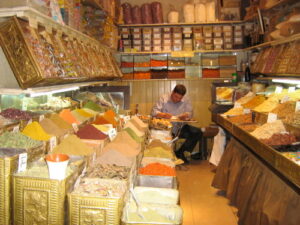
At the Hamiddiyya Souk |
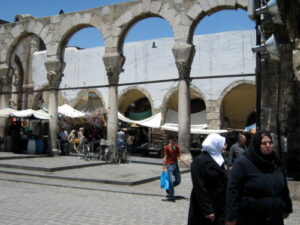
Outside the Hamidiyya Souk |
As an intern for Thara, I was involved in their projects in a variety of capacities. At the most basic level, I served as an editorial intern, going to the office each day and translating articles from Arabic to English to be posted on their website. I also sat in on interviews with women and journalists reporting on women’s issues, and on meetings with contributors and cartoonists. I got to see the day-to-day operations of the Thara magazine, observe their interactions with the government officials who came regularly to check up on their activities, and share their sense of commitment to their work and hope for the future.
I also got the opportunity to spend several days shadowing Ma’an abd-al-Salaam, the director of Etana Press (the parent NGO which runs Thara, along with a variety of other programs). With Ma’an and his associate Rania, I heard all about the office they were planning to open in Beirut and attended several meetings of the seminar on gender in Syria they were offering to a group of students and community members, who were about to leave for Germany to take part in an international conference on women’s rights.
I came into my experience at Thara feeling as if I knew nothing about where I was or what my role should be in such a viscerally unfamiliar context. All of my sense of intellectual preparation fell away, and I felt utterly foreign, unqualified, and unprepared. But this sensation, at first so uncomfortable, proved to be one of the most important things I experienced in Syria: it helped me to begin to reevaluate myself as a student of the Middle East. As I pursued my internship at al-Thara, I understood that I, too, had come to Syria with a set of expectations: I had hoped that the criticisms levied by the Western press about gender in the Middle East would prove unfounded, and that my findings would sustain my skepticism about international media coverage of the Middle East. As I delved deeper into these issues with my colleagues and mentors at al-Thara, however, I realized that I needed to lose sight of the answers I wanted to hear in order to ask more creative questions. I became a student in a way I’d never been before–I had no tools at my disposal but humility, confusion, and curiosity, which seemed to deepen with each question I asked.
Ultimately, what my experience in Syria did was to return me to a sense of wonder. After focusing academically on the language, history, and formation of the modern Middle East during my time at Yale, I realized in Damascus that what I love about the study of foreign cultures is not the collection of answers, but the constant expansion of my ability to ask questions about my passions–culture, society, and development in the Middle East–as my language skills grow. I also realized that the kind of local civic development work that organizations like Etana do is one of the best ways of effecting real change that matters to people on the ground, and I plan to spend the next several years exploring (both professionally and academically) how I can best contribute to that process. Thanks to the Chase Coggins Fellowship, I will never look at the region, or at my own study of it, in the same way.
Managing the National Petroleum Reserve-Alaska in the Common Interest
Kevin Currey
February, 2008
Report on Summer Research Experience
With the generous support of the Chase Coggins Memorial Fund, I spent eight weeks this summer studying the National Petroleum Reserve-Alaska. The 23-million acre NPR-A is the largest tract of federal land in the United States. It lies west of the Arctic National Wildlife Refuge and Prudhoe Bay in Alaska’s oil- and gas-rich North Slope region. The Bureau of Land Management, the federal agency responsible for managing the NPR-A, divided the area into three sections: northeast, northwest, and south. I focused my research on the 4.6 million acre northeast section, because the management of this area has been most contentious. The BLM opened a portion of the northeast section to oil and gas development in a 1998 Integrated Activity Plan/Environmental Impact Statement, and the agency opened even more of the area in a 2006 amendment to the 1998 document. A subsequent lawsuit by concerned conservation organizations forced the BLM to revise its 2006 analysis. In May 2008, the BLM released a supplement to the 2006 amendment that reversed many of the development expansions allowed in the 2006 amendment.
The broad goal of my research is to investigate whether the NPR-A is being managed in the common interest. To do so, I have tried to understand the social process surrounding the dispute over the NPR-A’s management and the decision process used by the federal government, purportedly to resolve that dispute. My work is guided by several subsidiary questions: What groups are involved in the EIS process, and with what outcomes and effects? What demands do they make, based on what values and expectations? How does the BLM incorporate different perspectives into its analysis and management decisions? Are BLM officials able to describe how they make decisions? What role does science play in the social and decision processes? How are scientific arguments used and misused by the different participants? Why did the BLM change its management strategies in 1998, 2006, and 2008? What social and political factors explain those changes? How do the Inupiaq Eskimos define the NPR-A policy problems? How do they participate in the debate? Are their voices being heard? In what ways does development help and hurt their well-being? Does oil and gas development affect their health, subsistence hunting, and cultural traditions? Are local and traditional knowledge collected and incorporated into the decision process? Will comprehensive development planning help mitigate the social, environmental, and political impacts of development?
To answer these questions, I used a methodology known as the policy sciences, a set of contextual, problem-oriented, and multi-method approaches to understanding the policy process. As the end of the spring semester and beginning of the summer, I engaged in a literature review, obtaining and reading relevant scientific articles, articles from local and national magazines and newspapers, integrated activities plans, environmental impact statements, records of decision, court decisions, and the transcriptions from public meetings about NPR-A. While in Alaska, I conducted interviews with 39 people representing about 25 unique organizations with a vested interest in the management of the NPR-A. A complete list of the interviews conducted is available in the appendix. During these semi-structured interviews, I asked the participants to explain their personal involvement in the NPR-A debates and to outline their organization’s involvement and position over time. I then asked a series of more specific questions about science, decision making, cultural issues. Some questions were standardized across all participants, and others were unique depending on the context.
I lived in Anchorage for most of the summer, but I made occasional trips to surrounding cities and also spent several days in Fairbanks. Although I did some library research, I spent most of my time in Anchorage interviewing participants in the NPR-A policy dispute. I talked with government officials from the Department of the Interior, the Bureau of Land Management, the Environmental Protection Agency, the Fish and Wildlife Service, and the Commission on Arctic Research. I also talked with representatives from several conservation organizations and oil companies, as well as from the Resource Development Council, North Slope Borough, the Arctic Slope Regional Corporation, and the Kuukpik Village Corporation. As I expected, each participant in the case offered a different perspective on the NPR-A, placing emphasis on different facts and values and in some instances framing the issues using drastically different worldviews. These interviews provided a better functional understanding of the disputes that have taken place and placed these disputes in a fuller, more nuanced context better than any other method has done so for me.
I devoted the final two weeks of my time in Alaska to traveling across the Arctic. I first visited Prudhoe Bay, the largest oil field in the United States. The plane flights in and out provided a good sense of the scope of development. I walked through some of the production facilities and saw the first drill site, where ARCO discovered oil in 1968. I also learned about the area’s history and current industry practices from workers and operators.
I then spent a week in Nuiqsut, a small native village of approximately 450 mostly Inupiaq Eskimo residents. I toured many of the town’s facilities, including the power plant, school, community center, teen center, health clinic, water treatment facility, AC store, and Presbyterian church. I had countless informal conversations with residents on the streets. I also hired a local translator and interviewed five of the village’s respected elders, most of whom have a very limited ability to speak and understand English.
They helped me understand how the Inupiaq culture has changed over time and offered a variety of explanations for and reactions to those changes. Speaking with the elders was one of my favorite experiences of the entire summer, and it provided a perspective on development and cultural change I could not have obtained in any other way. On my last night in Nuiqsut, I was invited to participate in an 18-hour oogruk (bearded seal) subsistence hunt in the Arctic Ocean. I saw first-hand how subsistence hunting works in the Arctic, from spotting and hunting the seals to preparing and eating the meat.
I cannot imagine how I could ever understand the challenges and opportunities facing the Inupiat in general and the people of Nuiqsut in particular without witnessing such an important aspect of their way of life in person.
Finally, I spent several days in Barrow, the northernmost town in the United States and the borough seat of Alaska’s North Slope Borough. I met with several members of the North Slope Borough staff, who helped me understand the Borough’s perspective on oil and gas development in the NPR-A and shared with me the results of some studies conducted by the Borough’s Wildlife Department.
Over the upcoming semester, I will work to analyze my data, refine my research question, and develop conclusions and recommendations. I am confident that my experience this summer will greatly enrich my senior thesis in Environmental Studies. I am extremely grateful for the tremendous opportunity to design and conduct my own research project. This was my first opportunity to conduct social science research in the field, and my skills greatly improved over the course of the summer. I really enjoyed the change to live and travel alone and to meet with so many extremely interesting people. There are not many opportunities to do so as an undergraduate, and I believe the experience is invaluable. This summer was the most exciting, educational, and enjoyable one I have had. Thank you again for helping to make this possible. I look forward to using what I have learned this summer in my professional career, where I hope to continue the search for creative, common-interest solutions to complicated policy problems.
Appendix: Alaska Interviews Summer 2008
- John Toppenberg Director, Alaska Wildlife Alliance
- Hans Neidig Special Assistant to the Secretary for Alaska, Dept. of the Interior
- Mead Treadwell Chair, U.S. Arctic Research Commission
- Jennifer Hillman BLM Policy Analyst, Alaska Wilderness League
- Jennifer Curtis NEPA Review/Compliance Officer, EPA-Alaska Operations Office
- Pat Pourchot Senior Policy Representative, Audubon Alaska
- Ted Murphy Deputy State Director, Division of Resources, BLM Alaska
- Jim Ducker Environmental Program Analyst, BLM Alaska
- Kurt Parkan Director of External Affairs, the Nature Conservancy
- John Payne Executive Director, North Slope Science Initiative
- Jason Brune Executive Director, Resource Development Council for Alaska
- Carl Portman Deputy Director, Resource Development Council for Alaska
- Rachel James Alaska Program Associate, Pacific Environment
- Jason Bergerson Research Analyst, North Slope Borough
- Jon Issacs Associate Planner and Director of Business Development, URS Corp.
- Mark Hanley Manager, Public Affairs, Anadarko Petroleum Corporation
- Tara Sweeney VP of External Affairs, Arctic Slope Regional Corporation
- Lanston Chinn CEO, Kuukpik Corporation
- Tom Lohman Attorney, North Slope Borough
- Natalie Lowman Director of Communications, ConocoPhillips Alaska Inc.
Anchorage Area
Fairbanks
- Lon Kelly Manager, Arctic Field Office, BLM Alaska
- Bob Schneider Fairbanks District Manager, BLM Alaska
- Jim Zelenak Biologist, U.S. Fish and Wildlife Service
- Pamela A. Miller Arctic Issues Coordinator, Northern Alaska Environmental Center
Nuiqsut
- Sam Kunaknana Mayor
- Isaac Nukapigak President, Kuukpik Corporation
- Heather Smith Pastor, Kuukpuk Presbyterian Church
- Rosemary Ahtuangaruak Community Activist
- Eli Nukapigak City Council Member
- Gina Rath City Administrator
- Marjorie Ahnupkana Elder
- Joe Ericklook Elder
- Amy Taalak Elder
- Annie Lampe Elder
- Joe Kasak Elder
Barrow
- Noah Ashley Wildlife Biologist, North Slope Borough
- Brian Person Wildlife Biologist, North Slope Borough
- Price Leavitt Executive Director, Inupiat Community of the Arctic Slope
- Glenn Sheehan Executive Director, Barrow Arctic Science
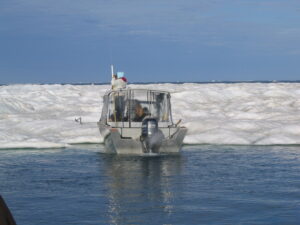 |
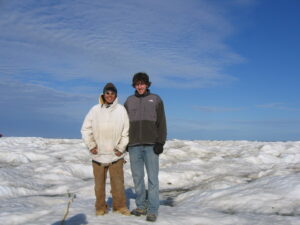 |
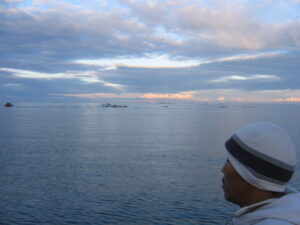 |
The Prevalence of Autism Spectrum Disorders in South Korea
Nicolas Abreu
Branford College
Yale Class of 2008
Thanks to the Chase Coggins Fellowship, I studied a wide range of issues surrounding children with Autism Spectrum Disorders (ASD) in South Korea. For eleven weeks, I conducted research in Seoul at the Korea Institute for Children’s Social Development. I spent the first couple of weeks working on a project analyzing data from thousands of autism screening questionnaires for a large-scale study of the prevalence of ASD in South Korea. I devised a series of algorithms to work with incomplete data and my results were then used to determine which children deserved follow-up assessments for ASD. I then designed and ran an experiment studying face recognition skills in children with ASD because there is a lack of research on face processing in children with ASD outside of Western cultures. I tested Korean children with and without ASD using a recognition memory test and my initial results suggest that just like Western children with ASD, Korean children with ASD also exhibit face recognition deficits. Extending this further, face recognition deficits might likely be a universal marker of ASD, not affected by the culturally defined social standards for face perception and eye contact. Finally, I absolutely adored the spare time I spent volunteering with an alternative school in Ilsan and the Institute.
This fellowship gave me a fantastic opportunity to pursue my academic interests in exciting new territory. Not only did I carry out some excellent work that I will use for my senior essay in Cognitive Science, but I have gained a deep appreciation for Korean culture and have developed a cross-cultural sensitivity when dealing with and discussing medical issues. I found that I am most fascinated by questions like “What is autism really?” and “How we can best define the disorder?” and by pursuing a career as a child psychiatrist, I will be able to more precisely determine what the core combination of cognitive, behavioral, and medical issues are in ASD so that we will be able to provide the best possible therapies to each and every autistic child.
Artistic response, by painting, to dinosaur digging and its landscape on a new tract in Wyoming.
Project page for David Muenzer Unfortunately we have little information on this project, if you are this person, or have more information, please contribute!Toward a Holistic Understanding of Malaria Prevention and Treatment in Mali.
Project page for Clare Cameron Unfortunately we have little information on this project, if you are this person, or have more information, please contribute!A bird survey in the upland forests of Savai’i, Samoa
John Mittermeier
Davenport College,
Class of 2008
Imagine a purplish-slate bird with the build of a bantam hen, bulging onyx eyes, coral red legs, a fiery bill and a dandelion yellow casque. While most of its close relatives scamper through sunny marshes, this bird – nocturnal and flightless – digs burrows into the mountainside of a tiny island in the middle of the South Pacific. This is the Samoan Moorhen (Pareudiastes pacifica), and no one had seen it for 130 years, until, in 2003, a reputable bird tour guide reported seeing a pair on the island of Savai’i, Samoa. With funding from the Chase Coggins Memorial Scholarship, the Environmental Studies Summer Internship Program, and the Yale College Dean’s Research Fellowship, I spent the summer of 2005 following up this report and trying to determine whether the Samoan Moorhen is in fact extant.
My work focused on the largest remaining forest block on the island – the uplands surrounding Mauga Silisili (“Top-of-the-top Mountain”). I started in early June in the northern section of the forest, where the 2003 report was made. For seventeen days, I camped along the edge of the Mata o le Afi (“the Eye of the Fire”) Volcano at 1500 m above sea level.
This area is a full day’s walk from the nearest village, A’opo, and there are no nearby water sources; almost certainly, my seventeen days represent a longer time than anyone has ever spent in this part of Savai’i’s interior. While there, I surveyed the area within a rough 1 km. radius of Mata o le Afi. This included the volcanic succession habitat around the crater itself, the forest between Mata o le afi and Mauga Mu (“Mountain of Flame”) to the west, the inside of the Mauga Mu crater, the forest on and around the unnamed mountain to the south of Mata o le Afi, the forest to the east between Mata o le Afi and Mauga Silisili, and the forest and marshy areas directly to the south of Mauga Silisili. In addition to this, I spent time sampling habitats at 1300 m and 1000 m above sea level along the A’opo – Mauga Silisili trail to the north of Mata o le Afi.
The 1000 m site is the exact area of the 2003 report; I did not concentrate the majority of my time here, however, because the forest farther inland was in better condition, and any moorhens seen at this lower elevation would likely be vagrants from the more pristine forest area.
After A’opo, I moved to the valleys near the 200-meter-high Sinaloa Waterfall on the south side of Savai’i’s upland forest; a half day’s walk inland from the village of Sili.
The scenery in this area was sublime; sheer cliffs studded with umbrella-like tree ferns, dozens of roaring waterfalls, and a perpetual cover of heavy gray clouds. Unfortunately, the weather and topography prevented me from carrying out many surveys in this area. It rained constantly and the forest understory – filled with fallen trees and secondary vegetation after being damaged by cyclones in the early 1990s – was virtually impenetrable. Access to the more remote areas was blocked by waterfalls, mudslides, surging rivers and tall cliffs. At one point, a flash flood forced my team to abandon camp and left us floating downriver on banana trunks! Work was further complicated by logistical difficulties in the village, most notably a village funeral which barred people from going into the forest for two weeks.
These difficulties limited my surveys to the valley directly below the Sinaloa Waterfall. I was also able to reach the lower areas of the Alia o le Gaoa (“Rugged Watercourse”) and the Alia o le Vanu (“Watercourse of the Chasm”), but was unable to explore as far as I would have liked.
Never once did I see any sign of the Samoan Moorhen or hear any convincing evidence of other people having seen it.
Hunters looking for pigs and pigeons visit the forest near Sili and A’opo with regularity.
In Sili, the two most active hunters reported having killed twenty pigs and numerous birds over an eight month period. They use hunting dogs (the Sili hunters brought a pack of 9-10 animals with them), and shoot and eat local birds including species as small as the Samoan Parrotfinch (Erythrura cyaneovirens). These men did not recognize pictures of the Samoan Moorhen and were unfamiliar with its Samoan name. At first glance, they confused pictures with “manuali’i,” the Purple Swamphen (Porphyrio porphyrio). When I pointed out the differences between puna’e and manuali’i – most notably the Moorhen’s bright yellow casque – they responded that they had “never seen this bird.’
My personal field observations included recording large numbers of feral rats, cats, pigs, and birds. Near Mata o le Afi, I found extensive evidence of feral cats – scat and bird kills – and observed Red-vented Bulbuls (Pycnonotus cafer), a recent introduction from Southeast Asia, in the upland forests.
Rats and pigs were common to abundant throughout the forests. All of these species heavily impact native bird populations; cats and rats in particular are incompatible with the survival of a flightless, ground-nesting bird like the Moorhen. A telling example is that of Stephen’s Island off New Zealand, where a single cat drove the island’s endemic wren to extinction in less than a year.
Invasive plants were also common, especially in areas which had been damaged by human activity, such as logging, or cyclones. Merremia vines completely blanketed some of the forest near Sili, choking out all other vegetation.
Near A’opo, I found that the exact area of the 2003 report had been heavily disturbed by recent logging roads. In addition to cats and rats, pigs were particularly abundant in this area as were extensive stands of invasive grasses and Merremia vines. Given this, I think it is unlikely that the 2003 moorhen sighting is accurate. My guess is that the birds seen were juvenile Purple Swamphens (Porphyrio porphyrio). These are a similar color and shape to the moorhen and, in the poor light of the forest interior, could be easily confused with one. Swamphens fly and are less susceptible to predation by invasive species than a Moorhen would be.
In my opinion, the Samoan Moorhen is extinct. Its decline corresponds to the arrival of Europeans and their foreign plants and animals. The Norway Rat (Rattus norvegicus), I would guess, is most to blame. It has populated all areas of Savai’i, depleted native arthropod and reptile populations and probably destroyed the Moorhen by predating eggs and chicks.
The inaccessible valleys around the Sinaloa waterfall could still provide a glimmer of hope. In the north, east and west of Savai’i, the more sloping terrain has permitted human access and disturbance, which in turn has allowed introduced species to spread. Near Sinaloa, however, forest patches in the upper areas of the Alia o le Vanu and the Alia o le Gaoa may still remain relatively untouched. With good equipment, knowledge of the topography, and a lucky stretch of weather it might be possible to reach the upper areas of these valleys and approach Mauga Silisili from the south side. At least two weeks would be necessary just to cut the preliminary trail. This is an extremely limited area though and any population of moorhens would be very small. I would be interested to hear survey reports from these areas.
Travel and interviews defining ‘the pursuit of happiness
Project page for Brian Reed Unfortunately we have little information on this project, if you are this person, or have more information, please contribute!Improving communication about water issues and usages on the Kenya-Tanzania border.
Project page for Laura Schewel Unfortunately we have little information on this project, if you are this person, or have more information, please contribute!Study on the experience of migration from the viewpoint of the Mexican side of the border.
Photographic essay on Bosnia after the War.
Project page for Lejla Hadzic Unfortunately we have little information on this project, if you are Lejla Hadzic, or have more information, please contribute!As difficult as such an intellectual endeavor may be, it is time to look at both sides of the Cuban coin, to work to eradicate the serious human rights abuses perpetrated by the Cuban government, while at the same time learning from the successes that same government has achieved.
My experience in Cuba, funded by the Chase Coggins Fund, was one of the most formative in my life. It was in Cuba that summer that I learned to hold paradox in my mind. Namely, on the one hand, Cubans do lack political freedoms. Yet, the standard of living was undeniably higher than it was in so many other Latin American countries I had visited. I wrote my senior essay on the research I had done in Cuba, and also wrote a play called Speak Easy Havana based on the experience.
I am deeply grateful for the experiences I had enabled by the Chase Coggins Fellowship.
Jocelyn Lippert Alt
Yale Daily News
Friday, April 11, 2003
Opinion Editorial, Page 2
The Fidel Castro you never knew
In his letter to the editor last week, Michael Bustamante ’06 discounts positive impressions of Cuban society as the result of government manipulation engineered to mask the true horror of the Cuban regime. (“Let’s get the Cuban government’s record straight,” 4/4)
The unbalanced view of the Cuban government to which Bustamante falls victim is shared by many in this country. In the recent coverage of the arrests of Cuban dissidents, there is a side to the story Americans are not hearing. And with the elimination of licenses for people-to-people educational exchange to Cuba, announced by the U.S. Office of Foreign Assets Control on March 24, one of the primary avenues open to Americans to hear the other perspective will be cut off.
While I was in Cuba last month on the Yale educational trip, it became clear to me that both the Cuban and U.S. governments and media are guilty of one-sided portrayals of the island. Cuban representatives never mention human rights violations; the United States talks of nothing but. Cuban representatives talk of the achievements of their government in the realms of health, education and environmental management; the U.S. media is silent on such matters.
These polarized positions on the Cuban government are unconstructive. The truth is more complex, and it is important to seek a middle ground in our intellectual understanding of this Caribbean enigma.
The 16 Yale students who traveled to Cuba this spring break on a Reach Out service-learning trip were fully aware that in meetings with Cuban officials and officially sanctioned members of Cuban society, we would hear a slanted story of the Cuban reality. All 16 students are enrolled in a semester-long seminar about Cuba and our professor left us with no illusions. We knew that we should take everything we saw with a grain of salt.
Indeed, in many meetings, we heard Cuban representatives extol the successes of the Cuban government since the 1959 revolution, in eradicating illiteracy, providing free health care for all, empowering women, curbing the spread of AIDS, protecting the environment, and more.
And, as Bustamante says, this view was undoubtedly one-sided. But — and this is what people opposed to the Cuban government often will not recognize — the fact that it was one-sided does not mean it was false.
UNICEF reports a literacy rate in Cuba of 96 percent and an infant mortality rate of 7 per 1,000 live births, a rate equal to that of the United States. In Bolivia, 79 percent of adult women are literate; 62 babies die per every 1,000 live births. These statistics are not empty numbers. Before the revolution, Cuba was characterized by the same huge income gap, low literacy rates, inaccessible health care for the majority of the population, and environmental degradation that marks many other Latin American countries.
Today’s statistics reflect real advances made in Cuba since the revolution that are the result of a determined commitment to improving these quality of life indicators, and are substantiated through individual accounts of everyday Cubans.
For example, in Cuba I met a 64-year-old man at a neighborhood gathering in a town called Vinales who told me about the jaw surgery he had last year. “I didn’t pay a cent,” he said. Under Cuba’s universally free health care system, staffed by thousands of doctors trained in medical schools established since 1959, the Cuban government covered the entire cost of this man’s surgery, hospitalization and food, and post-operational appointments.
While in Cuba, I walked to school with the 7-year-old girl whose family I stayed with in a remote inland town near Santa Clara. She wore a government-provided uniform and carried a backpack full of textbooks supplied by the government. Her grandparents had been illiterate, but she could read and write better than the second-graders I have tutored in New Haven.
Stories like these contrast sharply with conditions I have seen in other parts of Latin America.
While I was working at a school for the blind in Bolivia last summer, I met a man named Gustavo who lost his sight a year and half ago due to a brain tumor. He would have more than a 60 percent chance of his regaining his sight with an operation. But he can no longer work and cannot afford the $4,000 he would have to pay for the operation. Had Gustavo been a Cuban, he may have had to wait in a long line and suffer from the shortage of medicines that now plagues the Cuban health system, but he probably would have gotten that operation, and he may today have been able to see.
In El Salvador last spring, I met a 12-year-old boy in the town of Cuidad Romero who told me that only his eldest brother was able to go to school. His family, he said, cannot afford the uniforms and books for the other children and needs them to labor in the fields to earn money.
In Cuba, 10 people may live in a one cramped apartment, but the shanty towns of cardboard and tin houses that cover the landscapes of other Latin American countries are conspicuously absent.
Such things matter. At a time when millions of people in developing countries not only live in poverty, but also lack access to basic health care, education, housing, food, and clean water, the world ignores Cuba’s successes at its own peril.
The reality is that exemplary achievements and odious government repression exist simultaneously in Cuba. The everyday constraint of political freedoms is stark, and can be seen clearly in the control of the press and the intolerance of the expression of “counter-revolutionary” ideas.
In Havana, we met a Cuban university student studying English and German who deplored the discrimination against Cubans that prohibits them from entering the tourist hotels. He said he hates living in a country where he cannot express his views freely, that he wants to leave Cuba, and that Cuba must undergo reforms.
And although I did not hear of the incident until I came back to the United States, the round-up of dissidents accused of engaging in subversive activity began while I was still in Cuba. Some of the dissidents have now been sentenced to more than 20 years in prison. With these arrests and condemnations, the violation of rights we as Americans hold dear has reached a crisis point in Cuba, and it is critical that the international community do everything it can to protect the civil and human rights of Cuban citizens.
But efforts to open the political climate and protect against the breach of civil and human rights should not negate the advancements that Castro’s government has achieved.
When I asked the university student who expressed deep resentment of government policies what he thought about Fidel, he responded, “Castro is a great man. He has made some mistakes, but he wants the best for us.”
Cuba is a country of contradictions, and Cubans have practice living with the paradoxes. We owe it to them and to ourselves not to oversimplify our understanding of the island by confining ourselves to one-sided views.
As difficult as such an intellectual endeavor may be, it is time to look at both sides of the Cuban coin, to work to eradicate the serious human rights abuses perpetrated by the Cuban government, while at the same time learning from the successes that same government has achieved.
Jocelyn Lippert Alt was a junior in Timothy Dwight College. She is a former Staff Reporter for the Yale Daily News.
Effects of the history of educational inequalities in south Texas
Project page for Lori Flores Unfortunately we have little information on this project, if you are this person, or have more information, please contribute!Ariadna Khafizova
In the summer of 2001 The Chase Coggins fund allowed me to travel to Dharamsala, the Tibetan capital in exile, to work at Norbulingka Institute (www.norbulingka.org) and learn more about its mission to preserve traditional Tibetan art and culture while providing recent refugees with apprenticeships that offered them a chance to earn a living. While my initial intent was to learn more about the religious underpinnings of the artistic forms practiced at Norbulingka, the project evolved into a collection of oral histories. I spoke with a number of refugees, among them monks who participated in rebellions against the Chinese rule, were imprisoned, and then fled to India to practice their religion and openly venerate His Holiness the Dalai Lama. Other interviewees came for economic opportunities that were lacking in their remote villages, preferring to move to India instead of mainland China because they felt educationally disadvantaged by their lack of training in the Chinese language. What drew me to the stories was the immediacy of the experience and the similarity to what my own family had gone through in the early years of the Soviet Union, being forced to abandon their land and religion with the advance of communism into the Urals. This potent reminder of universality of human suffering and resilience has remained with me many years after that summer, urging me to be responsive to social injustice and natural disasters, wherever they may occur.


